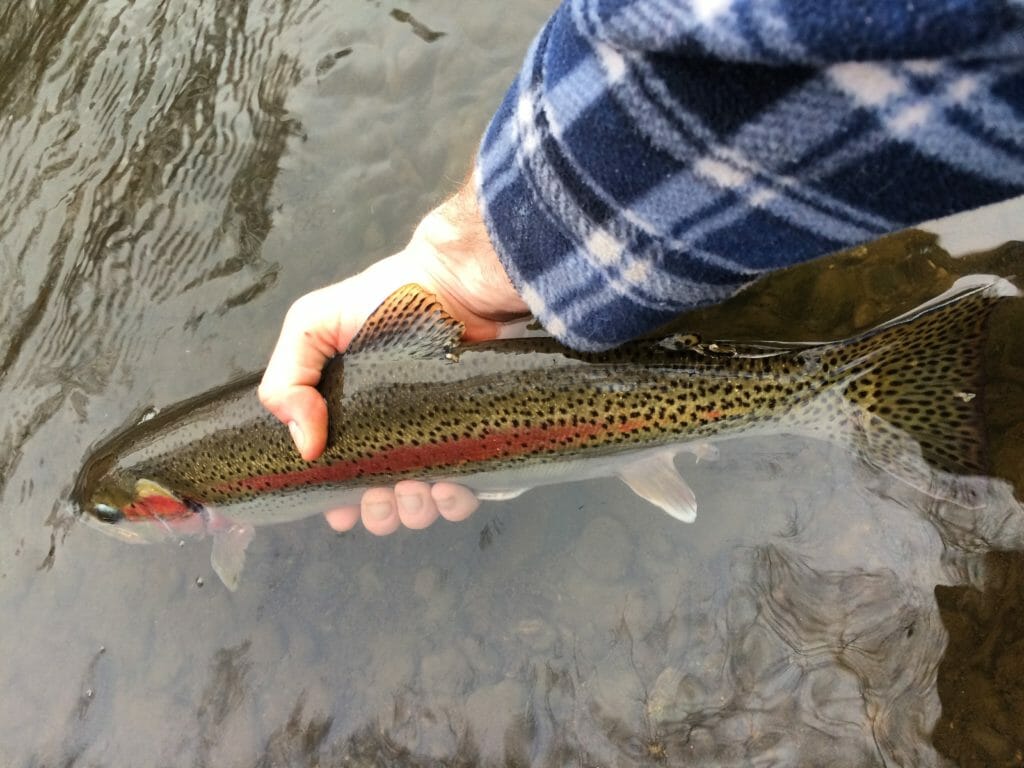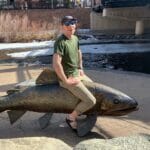Several streams draining from the mountains that enhance my urban viewscape snake their way through Anchorage, paralleling urban trails, bordering neighborhoods and sometimes disappearing underground for blocks at a time. While the aesthetics and natural state of the creeks range from non-existent to surprisingly impressive, for an angler it’s difficult not to look at the flowing water, assess the potential lies of hungry fish, and subsequently think, “I wonder if there is a fish there?”
Well, you don’t know until you find out. After having stopped at several “fishy looking” holes during runs on my local pedestrian trail to ponder the aforementioned question, I finally took an hour to return with my fly rod.
The holes in question immediately became my local honey holes. Over the past several years I have effectively doubled my days on the water simply by exploring the streams just down the street and have been shocked by several of the stretches of urban creek where I have found trout.
I recognize that every city and its available flowing waters vary widely, but here are some suggestions from my urban fishing experience in Anchorage.
- Adjust your expectations— Chances are these are not blue-ribbon fisheries to be accessed behind the local baseball fields. Your expectations should reflect that. Consider them an immediate source of fishing respite when stuck in town or an opportunity for an exciting lunch break. Every fish counts, no matter the size and whether or not it makes it to hand. Celebrate the small victories. After all, it beats the pants off eating lunch from your desk or holding down the couch at home.
- Rise to the challenge —The creeks I find myself on are very small and wrought with hazards including challenging casts and limited or non-existent back cast room. They demand creative approaches. There’s a learning curve and it hasn’t always been pretty, but I am a better angler for tackling these obstacles.
- Focus on similarities – Yes, you have found yourself in a drastically different setting than you are used to, but the primary goal of catching fish remains the same. Presumably you have gathered local knowledge on other creeks in your geographic area and the species, food supply, and habits of fish remain largely the same. Turn to what you have learned on the wilder cousins of these urban streams and apply that knowledge here.
- Start on a stretch of water that suits you — Review maps to determine access points and sections of the creek that appeal based off the experience you are looking for. Consider things such as proximity to home or work, the natural character of the stream and surrounding area of the stretch, and other uses of the stretch that may impede your fishing.
- Go “prospecting” — When I approach a new stretch of an urban waterway, or have only a limited amount of time, I do two things: 1) tie on a fly that I know will attract fish and that I am confident in my ability to present. My go-to fly is a size 10 Woolly Bugger in olive or black, frequently with a “hot head,” and 2) cover water and prioritize making casts in the places you think are most likely to hold fish.
- Accessibility is mobility — This can come in handy when jetting out for a quick fishing mission or trying to explore larger sections of your urban waters. Pedestrian trails, bike paths, and user trails cut down on frustrating bushwhacking and equal more time on the water.
- Research produces results — A little bit of homework can go a long way in improving your experience and success. Check with your local Fish and Game agency to learn about stocking history (if any) to have an idea of what species are in the creek and how prolific their presence may be. As always, consult the fishing regulations for the waters you intend to fish to ensure that you are in compliance.
- Bring a plastic bag — You will reliably encounter litter, and if you are anything like me, you’ll think twice about walking past it, especially once you’ve pulled a fish from the adjacent waters. My sling pack is loaded with a stash of plastic bags to pick up trash while I fish.

Though many will turn their nose up at fishing amongst sewer drains and sometimes questionable water quality, I consider it a treat to be able to catch rainbow trout and observe migrating salmon within walking distance of my house.
Each fish found is a reminder of the stream’s former self, and while it may no longer fully encompass the entirety of its historical beauty and allure, there is still plenty of delight to be found, and not just below the water’s surface.
Eric Booton is the sportsmen’s outreach coordinator for TU’s Alaska Program. He lives and works in Anchorage.



